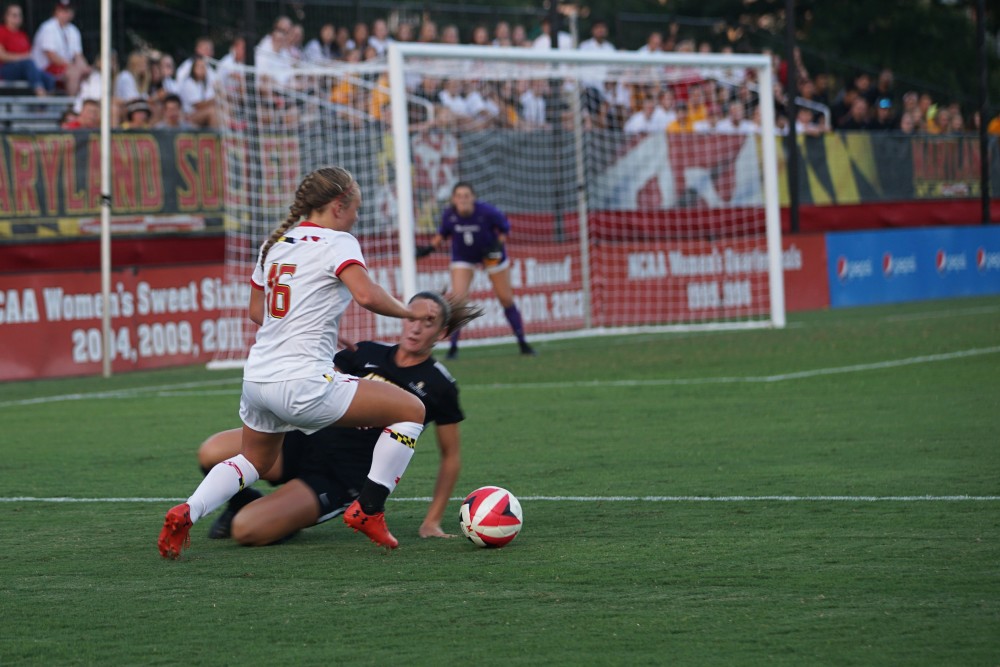When Maryland women’s soccer broke its roughly 363-minute scoring drought in a 1-1 draw against UCF on Sept. 6, the Terps did so with fluid buildup play.
The rare scoring chance materialized after defender Jenna Surdick won the ball in the Maryland half and found midfielder Darby Moore at the center line. Moore fed midfielder Hope Lewandoski on a well-placed through ball, and the sophomore split the Golden Knights’ defense with a cross-field pass to forward Alyssa Poarch.
After a pair of saves by Golden Knight goalkeeper Vera Varis on back-to-back Poarch attempts, Lewandoski slotted the ensuing rebound in the corner of the net for an equalizing goal. Going forward, the Terps (2-3-3) will need more than a few glimmers of ball movement to successfully penetrate opposing Big Ten defenses, beginning with Iowa on Friday.
“Obviously, we’ve got a lot of work to do,” coach Ray Leone said. “[The forwards] are just working hard, working hard, but they’re not really being as aware of each other as they should. And that’s something we really have to focus on right now.”
[Read more: Despite nonconference struggles, Maryland women’s soccer feels ready for Big Ten play]
A contributing factor to the lack of chemistry on the frontline has been Maryland’s frequent substitutions.
Injuries were rife last year in the Terps’ attack, so Leone has opted to frequently rotate to preserve their health through the season. The strategy has kept players fit, but hasn’t offered much time for players to develop in-game rapport.
At practice Tuesday, Leone said the team would focus heavily on pattern play in the coming days to open up scoring chances for attackers. With the exception of their string against UCF, the Terps’ attacking plight has been a consistent problem for the team, considering they’ve failed to score in four of their previous five matches.
[Read more: Maryland women’s soccer shuffled its lineups to stay fresh through nonconference play]
Even when Maryland controls possession, the offensive futility has often persisted. Against Temple on Aug. 31, Maryland had a 17-6 shooting advantage, but none of the Terps’ attempts threatened the Owls’ goalkeeper.
However, in the two games last week, the team’s buildups seemed to improve. Still, it remains to be seen if that will translate into future scoring opportunities.
“The way that we’re moving up the field and doing it as a unit is making such a big difference,” forward Jarena Harmon said. “We’re getting more opportunities because we’re staying in the opposing team’s half. So it’s much better.”
While UCF outshot Maryland, the Terps nearly managed a win. Before Lewandoski’s second-half goal, Maryland almost equalized with minutes remaining in the first half.
A looping pass from Harmon found midfielder Loren Sefcik open, and the Golden Knights needed a diving stop from Varis to keep the freshman’s effort out of goal. The rebound went directly to Poarch, but she missed wide right.
Despite the let off, the chance showed that while Maryland has struggled in the final third, the Terps can generate chances. When Big Ten play begins against Iowa this week, Maryland will need to bring the same rhythm on offense it showcased against UCF.
“In nonconference play, we’ve really been testing the waters,” Moore said. “By the time conference comes … I think we’ll be really ready to really try out everything that we have and come at it full fledge.”



